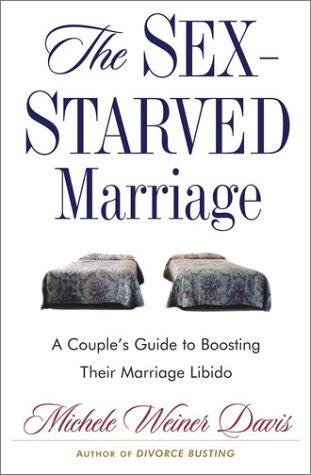Electronic Journal of Human Sexuality, Volume 6,
Jan. 29, 2003
www.ejhs.org
The Sex-Starved Marriage:
The Couple's Guide to Understanding Mismatched Sexual
Desire and Boosting Their Marriage Libido
Michele Weiner Davis
2003, Simon & Schuster
ISBN: 0-7432-2732-8
U.S. $24, CAN $ 38

Click on this cover and buy this book for $16.80
Reviewed by Annette Owens, M.D., Ph.D.
Desire discrepancy is one of the most common occurrences that lead couples
to seek professional help. Sex counselors and therapists as well as marriage
counselors frequently encounter couples with one partner less interested
in sex than the other. In her latest book The Sex Starved Marriage,
marriage therapist Michele Weiner Davis presents a vivid picture of intra-
and interpersonal dynamics in such relationships. Based on decades of experience,
she describes common feelings, thoughts, concerns and interactions of the
partner with the lower sex drive as well as the higher-drive individual.
In a direct, candid style, Weiner Davis lists the possible causes why
one partner's sex drive may be reduced. It sometimes does not require much
difference in sexual desire to start a negative cycle, which can become
a downward spiral. For those individuals who want to change these unhealthy
and unhappy dynamics, Michele Weiner Davis emphasizes that both partners
must become involved to effect a desirable change. She offers excellent
advice on how to initiate the process as well as suggestions on how to
improve the overall relationship, subsequently improving sexual desire
and satisfaction.
I was pleased to read a lengthy discussion of Dr. Rosemary Basson's
new model on sexual arousal and desire (Basson 2001). According to her
model, women in longer-term monogamous relationships often do not initially
experience sexual desire (conscious sexual urging, thinking, fantasizing)
moving on to arousal, plateau, orgasm and resolution phases of the traditional
sexual response cycle of Masters and Johnson (1966) and Kaplan (1979).
Instead, more commonly, a woman's sexual arousal actually precedes her
sexual desire. Only after a period of sexual arousal does she experience
sexual desire, which will often lead to further arousal. Several men have
told me that this model of sexual desire also is true for them.
Besides reflecting many of Weiner Davis' personal experiences, the book
is well-founded on other important, recent contributions to our field,
such as Dr. John Gottman's principles for healthy communication (Gottman
& Silver 1999) and Dr. David Schnarch's second-generation approach
to sex therapy, that is based on the Sexual Crucible™ theory and provides
a new approach to treating desire disorders (Leiblum & Rosen 2001;
Schnarch 1997).
The book does not specifically address situations where a partner may
have reduced sexual desire and where sexual frequency is low or even absent
because of severe pain (vulvodynia, chronic back pain, etc.). This is a
general guide on how to improve a marriage or committed long-term relationship
on several levels, including the desire leading to sexual interactions.
For more complex cases that may benefit from intervention of certified
sex counselors or therapists, Weiner Davis appropriately refers the reader
to the American Association of Sex Educators, Counselors, and Therapists
(AASECT). However, I predict that thousands of couples – not just in the
United States – can benefit from her suggestions. Sex starved marriages
and relationships are universal. This book provides a promising tool for
creating better marriages and committed long-term relationships.
In conclusion: The Sex Starved Marriage is an important resource
for individuals and couples wanting to improve their overall as well as
sexual relationship. Founded on recent, well-accepted research and principles,
it also serves as a guide for professionals who assist couples in overcoming
desire discrepancy. I highly recommend this book.
Other books by Michele Weiner Davis: The Divorce Remedy: The Proven
7-Step Program for Saving your Marriage, Getting Through to the Man You
Love, Change Your Life and Everyone in It, Divorce Busting: A Step-by-Step
Approach to Making Your Marriage Loving Again, and in collaboration
with William Husdon O'Hanlon In Search of Solutions: A New Approach
to Psychotherapy.
References:
Basson, R. (2001) Using a Different Model for Female Sexual Response
to Address Women's Problematic Low Sexual Desire. Journal of Sex and
Marital Therapy, 27: 395-403.
Gottman, J.M. & Silver, N. (1999) The Seven Principles for Making
Marriage Work. Crown, New York.
Kaplan, H.S. (1979) Hypoactive Sexual Desire. Journal of Sex and
Marital Therapy, 3: 3-9.
Leiblum, S.R. & Rosen, R.C, eds. (2000) Principles And Practice
Of Sex Therapy, Third Edition, The Guilford Press, New York, London.
Masters, W.H. & Johnson, V.E. (1966) Human Sexual Response.
Little, Brown, Boston.
Schnarch, D. (1997) Passionate Marriage. Holt, New York.
Return to Front Page
